The zebra finch is so well known that it needs little introduction in terms of appearance and captive care. However, the details of its entry into the pet trade, importance as a laboratory subject and fascinating natural history are often overlooked. Please read on…you might be pleasantly surprised at the stories behind this pert little pet trade staple.
A Lesser Known Zebra Finch from Timor
There are actually two distinct races of zebra finches. The nominate race, (the first to be described scientifically) was brought to the attention of European taxonomists in 1817. Known as the Timor zebra finch, Taeniopygia guttata guttata, it is native to Timor and other of Indonesia’s Lesser Sunda Islands, which lie in the Timor Sea about 250 miles north of Australia. Only rarely seen in captivity, this bird is much smaller than the Australian subspecies, and its song is more complex
The Australian Zebra Finch Enters the Pet Trade
 The Australian race, T. g. castenosis, was described in 1838 and was imported into Europe shortly thereafter. An immediate avicultural hit, the zebra finch was being bred regularly in Germany by 1872 and was featured in bird shows in England and elsewhere by the early 1900’s. The new arrival proved easy to breed, and importations from the Australia slowed down considerably by 1915.
The Australian race, T. g. castenosis, was described in 1838 and was imported into Europe shortly thereafter. An immediate avicultural hit, the zebra finch was being bred regularly in Germany by 1872 and was featured in bird shows in England and elsewhere by the early 1900’s. The new arrival proved easy to breed, and importations from the Australia slowed down considerably by 1915.
In 1962, Australia imposed severe restrictions on the export of native wildlife…few if any wild zebra finches have entered the pet trade since that time. By 1969, it was estimated that approximately 80 generations had been produced in captivity without the addition of “wild” genes, leading many to consider the zebra finch as a largely “domesticated” species.
Natural Range and Habitat
Zebra finches are among the most common and widely distributed of Australia’s birds, being absent only from tropical Cape York Peninsula in the north and along portions of the southern and eastern coasts.
Although most at home on the dry, largely treeless grasslands of the interior, zebra finches have adapted to human presence and readily colonize overgrown fields, scrub, farms, ranches and gardens. Indeed, the presence of wells and other artificial water sources has resulted in significant range expansions. Their kidneys are extremely efficient at removing moisture from food, and they are even able to drink brackish water, a facility that enables this hardy finch to survive in salt marsh habitats.
Reproduction in the Wild
The zebra finches’ breeding biology is tied to rainfall and temperature, and varies greatly across its vast range. Populations in the center of the continent can breed whenever the unpredictable rains arrive, regardless of the season. Breeding is tied to temperature in the east and southeast, where rainfall is regular and predictable. In southern and southwestern Australia, the winter rains are heavy and would destroy the nests, and the summers are extremely hot. Breeding is therefore limited to the relatively brief intervals of warm weather and light rainfall.
Zebra finches are as adaptable in nesting behavior as they are in the timing of their breeding. Nests have been found in trees and tree hollows, shrubs, mounds of dead grass, on the ground, within the nests of termites and larger birds and even below ground in rabbit tunnels. These enterprising little birds will also adopt artificial nest sites, and often set up house-keeping in spaces under the eves and roofs of houses, and in abandoned or open barns and other structures.
Further Reading
A very interesting account of personal observations of zebra finches and other Australian birds in the wild is posted at http://www.zebrafink.de/en/zfinf-au.htm.
 That Bird Blog – Bird Care and History for Pet Birds
That Bird Blog – Bird Care and History for Pet Birds

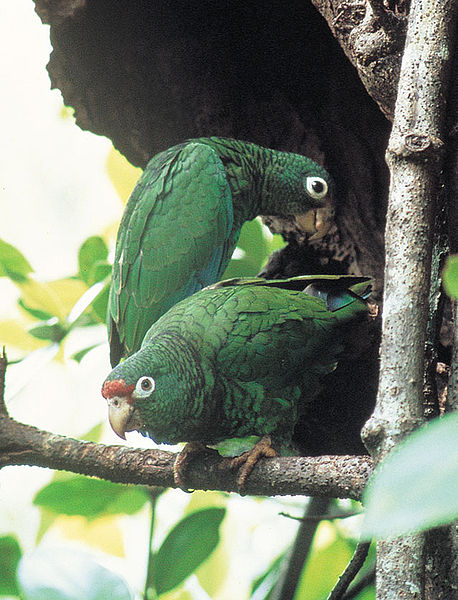 With only 30-35 individuals remaining in Puerto Rico’s Loquillo Mountains, this is quite likely the Neotropic’s rarest parrot. A related subspecies on nearby Culebra Island became extinct in 1912. The captive population of approximately 100 birds (which suffered serious losses due to thievery in 2001) is managed by the US Fish and Wildlife Service.
With only 30-35 individuals remaining in Puerto Rico’s Loquillo Mountains, this is quite likely the Neotropic’s rarest parrot. A related subspecies on nearby Culebra Island became extinct in 1912. The captive population of approximately 100 birds (which suffered serious losses due to thievery in 2001) is managed by the US Fish and Wildlife Service. I was very fortunate to have observed this colorful and rare bird while working with leatherback sea turtles on its tiny island home. I had not really expected to see it at the time, and the intervening 20 years have not dulled the very pleasant memory.
I was very fortunate to have observed this colorful and rare bird while working with leatherback sea turtles on its tiny island home. I had not really expected to see it at the time, and the intervening 20 years have not dulled the very pleasant memory.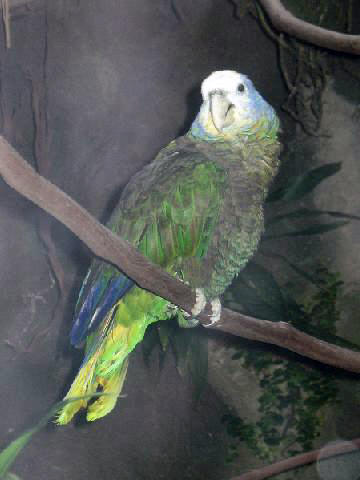 Another oddly marked (for an Amazon parrot) Caribbean island denizen, this parrot’s plumage contains a good deal of black, blue and violet, offset by orange, red and white about the head.
Another oddly marked (for an Amazon parrot) Caribbean island denizen, this parrot’s plumage contains a good deal of black, blue and violet, offset by orange, red and white about the head. The word “bright” comes to mind the first time one views this bird’s brilliant blue, green and red plumage…usually that view is of a photo, unfortunately, as the bird itself is exceedingly rare. All but 2 of the specimens known to be in the USA are housed at Florida’s Rare Species Conservancy.
The word “bright” comes to mind the first time one views this bird’s brilliant blue, green and red plumage…usually that view is of a photo, unfortunately, as the bird itself is exceedingly rare. All but 2 of the specimens known to be in the USA are housed at Florida’s Rare Species Conservancy. Yellow-napes are considered by many to be the ultimate parrot pet, and certainly their reputation for great intelligence is well-deserved. Large (to 16 inches), boisterous, vocal and active, the yellow-nape is best acquired as a hand-raised youngster. Birds that are not well-socialized when young are a real handful, and best left to very experienced (and patient!) aviculturists. Yellow napes do tend to use their powerful beaks to “make a point”, a further reason why well-tamed individuals are recommended.
Yellow-napes are considered by many to be the ultimate parrot pet, and certainly their reputation for great intelligence is well-deserved. Large (to 16 inches), boisterous, vocal and active, the yellow-nape is best acquired as a hand-raised youngster. Birds that are not well-socialized when young are a real handful, and best left to very experienced (and patient!) aviculturists. Yellow napes do tend to use their powerful beaks to “make a point”, a further reason why well-tamed individuals are recommended.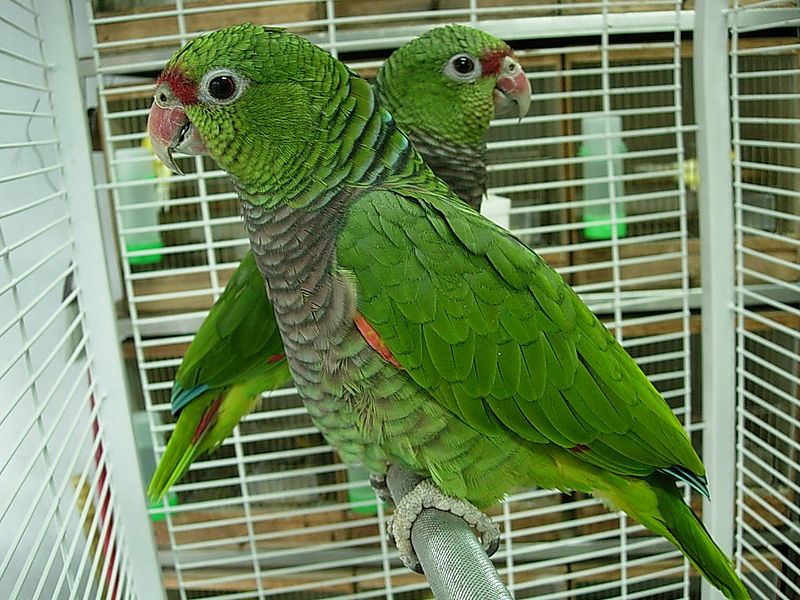 The vinaceous Amazon differs from its relatives in general personality traits, being rather shy and retiring. Most have none of the “swagger” associated with its raucous cousins, and make gentle, affectionate pets. They fare best in quiet surroundings, and should be approached slowly, even when well-habituated to captivity.
The vinaceous Amazon differs from its relatives in general personality traits, being rather shy and retiring. Most have none of the “swagger” associated with its raucous cousins, and make gentle, affectionate pets. They fare best in quiet surroundings, and should be approached slowly, even when well-habituated to captivity.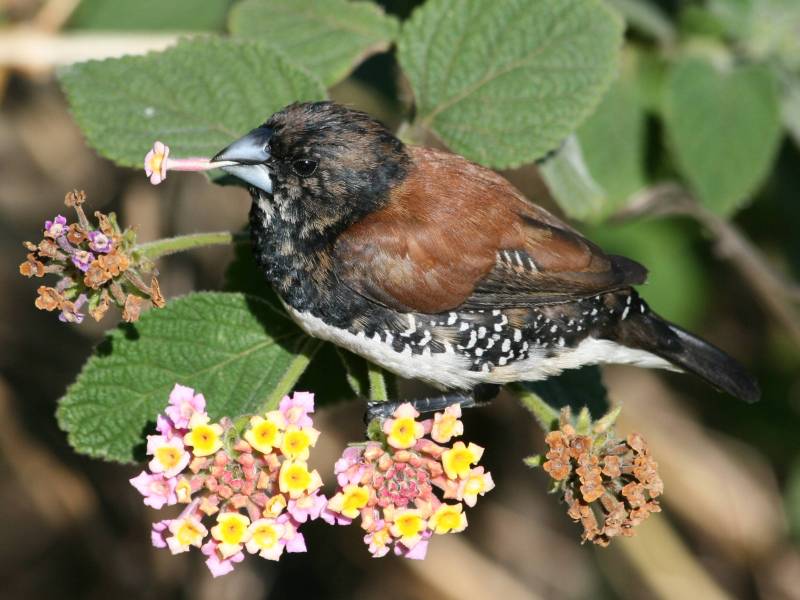 Barely reaching 3.8 inches in length, this Southeast Asian native is the smallest of the genus, and indeed of all Estrildid finches. Its black feathers are highlighted with a glossy green, while the lower breast and under-parts are white. The Fernando Po is not very common in the trade, but well worth seeking. Its tiny size and active, inquisitive nature render it a charming pet.
Barely reaching 3.8 inches in length, this Southeast Asian native is the smallest of the genus, and indeed of all Estrildid finches. Its black feathers are highlighted with a glossy green, while the lower breast and under-parts are white. The Fernando Po is not very common in the trade, but well worth seeking. Its tiny size and active, inquisitive nature render it a charming pet. Hobbyists are sometimes surprised to learn that this pet trade staple is not to be found in the wild, but rather is a captive-generated hybrid. Developed in Japan by breeding sharp-tailed munias (L. acuticauda) with striated munias (L. striata) the Bengalese has much to recommend it as a pet. It is extremely hardy, adaptable to cage or aviary, and especially useful as a foster parent to more sensitive finches. In fact, so well-developed are its parental instincts that pairs sometimes take-over the broods of unrelated birds with whom they are housed! Their breeding habits are also quite flexible, with 2 or more hens sometimes depositing their eggs in the nest of one, which happily goes about raising all the chicks.
Hobbyists are sometimes surprised to learn that this pet trade staple is not to be found in the wild, but rather is a captive-generated hybrid. Developed in Japan by breeding sharp-tailed munias (L. acuticauda) with striated munias (L. striata) the Bengalese has much to recommend it as a pet. It is extremely hardy, adaptable to cage or aviary, and especially useful as a foster parent to more sensitive finches. In fact, so well-developed are its parental instincts that pairs sometimes take-over the broods of unrelated birds with whom they are housed! Their breeding habits are also quite flexible, with 2 or more hens sometimes depositing their eggs in the nest of one, which happily goes about raising all the chicks.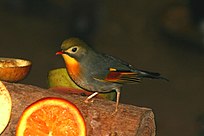 Ranging from the southern Himalayas to eastern China and south into Myanmar, Pekin robins are largely birds of high-altitudes. They frequent forest underbrush and clearings on mountainsides, and are rarely seen out in the open. They will also forage on farms and in gardens, where they are much appreciated for their insect-catching abilities.
Ranging from the southern Himalayas to eastern China and south into Myanmar, Pekin robins are largely birds of high-altitudes. They frequent forest underbrush and clearings on mountainsides, and are rarely seen out in the open. They will also forage on farms and in gardens, where they are much appreciated for their insect-catching abilities.